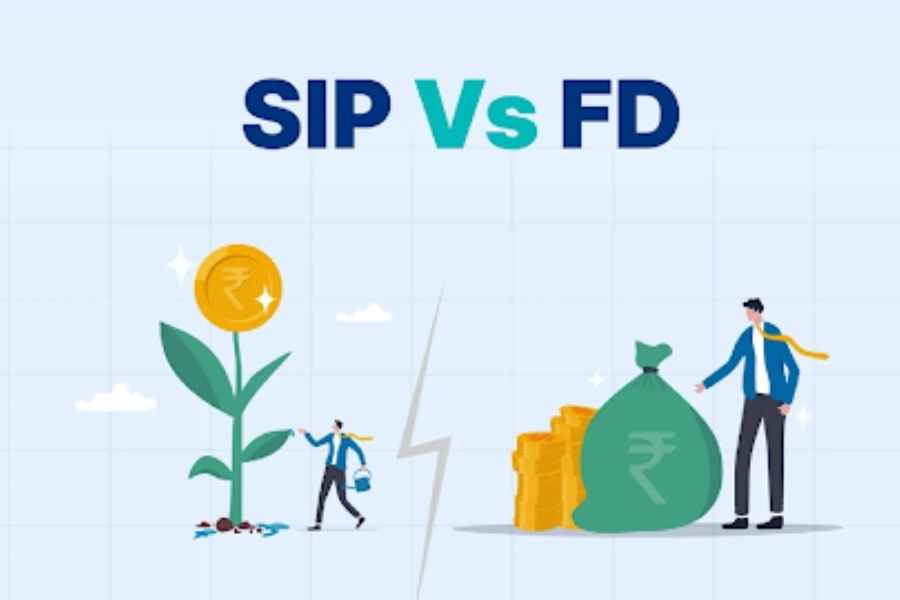Two popular ways to invest money in regular instalments are Recurring Deposits (RD) and Systematic Investment Plans (SIP). While both involve disciplined investments, they serve different requirements and cater to different types of investors. Let’s break down the key differences between RD and mutual funds for SIP and help you decide which is more suitable for you.
What is an RD?
A recurring deposit (RD) is a fixed-income investment offered by banks, non-banking financial institutions, and the Indian post office. It is a simple savings option where you deposit a fixed amount every month for a pre-decided tenure, at a fixed interest rate. At the end of the tenure, you receive the principal amount along with interest.
Features of an RD:
- Guaranteed returns: The interest rate is fixed at the time of opening the RD, so you know exactly how much you will get at maturity.
- Low risk: Since RDs are backed by banks and post offices, they are typically safe.
- Tenure flexibility: RDs can have tenures ranging from a few months to several years.
- No market exposure: Your money is not affected by stock market fluctuations and returns are fixed.
However, while RDs are safe and predictable, their returns are limited compared to market-linked investment options.
What is an SIP in mutual funds?
A Systematic Investment Plan (SIP) is a way to invest regularly in mutual funds. When you pick a mutual fund for SIP, you invest a fixed amount of money periodically (usually monthly) into a mutual fund scheme. Over time, your investments can potentially grow based on the market performance of the underlying assets in the fund.
Features of an SIP in mutual funds
- Market-linked returns: The returns are based on the performance of the stock market and other assets like bonds or gold.
- Power of compounding: SIPs benefit from compounding, where your returns earn further returns over time. This can result in significant growth potential in the long term, especially in equity-oriented funds.
- Rupee cost averaging: SIP investments allow you to buy more units when prices are low and fewer when prices are high, reducing the average cost of investment.
- Flexible tenure and amount: You can start with as little as Rs. 500 per month and continue for as long as you want.
While SIPs carry market risk, they have the potential to generate higher returns over the long term compared to traditional fixed-income options like RDs.
Key differences between RD and SIP mutual funds
| Feature | RD | SIP in mutual funds |
|---|---|---|
| Returns | Fixed and guaranteed | Market-linked, can be higher or lower |
| Risk | Low (no risk of losing money) | Moderate to high (depends on fund type) |
| Flexibility | Fixed tenure and deposit amount | Flexible tenure and investment amount |
| Liquidity | Limited (premature withdrawal may incur a penalty) | High (mutual fund units in most schemes can be redeemed anytime, though charges may apply) |
Which one should you choose?
Choosing between an RD and an SIP depends on your financial goals, risk appetite, and time horizon. Here’s a quick guide to help you decide:
Choose RD if:
- You want guaranteed returns: If safety and predictability are your top priorities, RD is a better option.
- You don’t want market risks: RDs are suitable for those who don’t want to deal with the ups and downs of the stock market.
- You need short-term savings: RDs are ideal for goals like buying a gadget, funding a vacation, or building an emergency fund.
Choose mutual funds for SIP if:
- You aim to build wealth over time: If you are comfortable with risk, SIPs in equity funds can help you potentially earn inflation-beating returns in the long term. An SIP calculator online can help you visualise the impact of time on your growth potential by showing you the possible returns on your investments over different horizons.
- You want to beat inflation: Over time, mutual funds have the potential to deliver inflation-beating returns, which RDs may not.
- You need liquidity: SIPs in mutual funds offer flexibility to withdraw your money as needed without significant penalties, making them ideal for short- to medium-term financial goals.
- You are comfortable with risk: Mutual funds can yield higher returns than traditional avenues, but they involve exposure to market volatility.
Both RD and SIP mutual funds have their own advantages. RDs are predictable, while SIP investment plans offer the potential for higher returns and wealth creation. If you are just starting with savings and prefer low-risk, RD is a good option. But if you’re seeking long-term financial growth and can handle market fluctuations, SIP mutual funds could be the better choice.
Even conservative investors can consider an SIP in a debt mutual fund. Such funds offer reasonable return potential (comparable to or higher than RDs, depending upon the type of fund and investment horizon) and are less risky than equities. Typically, they can entail low/low-to-moderate/moderate risk, depending on the scheme category. Moreover, they also offer liquidity, which means you can access your money if you need funds, unlike with RDs.
Remember, the suitable option for you will depend on your financial goals, risk tolerance, and investment horizon. It is also advisable to consult a financial advisor to create a plan that works for your needs.
Mutual Fund investments are subject to market risks, read all scheme-related documents carefully.




